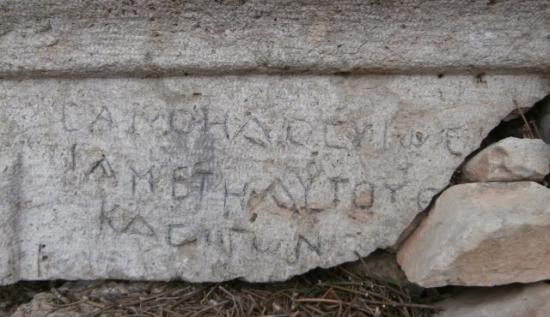Samuel and his family rediscovered 1,800 years later in the cemetery of the former Jewish capital in Galilee.
Ran Shapira
http://www.haaretz.com/archaeology/.premium-1.631190

The stone from the ~1,800-year old Jewish tomb: 'Samuel son of… and his wife… and his entire family'Photo by Dr. Mordechai Aviam
A roughly 1,800-year old stone inscription from a Jewish tomb has been found in the wall of a 19th-century Muslim mausoleum in the Upper Galilee, where it was repurposed from being part of a door lintel to part of a wall.
The partially broken stone is written in Greek, not Hebrew or Aramaic, which is the usual language on ancient Jewish tombs. But it lists the members of a clearly Jewish family that lived in Zippori, then called Sepphoris, between the 2nd and 5th centuries CE.
According to the inscription, "Samuel son of… and his wife… and his entire family" were buried at the site.
The Muslim mausoleum was one of hundreds of walled tombs in the vicinity of Zippori, once the burgeoning, densely-peopled Jewish capital of the Galilee.
Today there is a moshav on the site, before the 1948 War of Independence, the site had been the location of a large Arab village, Saffuriya. But 1,800 years ago, it was a mainly Jewish city.
Archaeologist Dr. Moti Aviam discovered the inscription while surveying the ancient cemeteries of Sepphoris together with Aharoni Amitai, both of the Kinneret Academic College. It was part of a door lintel, which in turn was apparently part of the entrance to a stone tomb in the ancient Jewish cemetery of Zippori.
Why would a Jewish memorial be written in Greek? It may attest that Samuel and his family belonged to the Zippori elite – and therefore, most likely spoke Greek. Also, the tomb is in the western part of the ancient Zippori cemetery, which "housed" members of the town elite.
During their survey, the archaeologists located, marked and examined dozens of ancient tombs. Most were tombs of the Jewish residents of Zippori between the first and fifth centuries CE, though some seem to date from the 6th century. Most of the inscriptions are in Hebrew or Aramaic.
Losing out to Tiberias
Zippori was the Jewish capital of the Galilee from the 1st to the 4th centuries CE, when it was supplanted by Tiberias. Early in the 3rd century it was the home of Rabbi Judah Hanasi and the Sanhedrin.
Comprehensive archaeological excavations conducted there over the last 35 years revealed streets, numerous synagogues, markets, homes, and some of the most elaborate mosaic floors in Israel. (Most can be seen in a visit to the Zippori National Park.)
The survey also discovered that the tombs in Zippori were dug in close proximity, indicating that the city was densely populated between the 2nd and 4th centuries C, say the scholars.
According to Aviam, as Tiberias ascended in status, the Jewish community in Zippori dwindled. With the advent of the Muslim era in the 7th century, the village of Saffuriya started rising on the ruins of the Jewish capital. Its main development was during the Mamluk period (13th to the 16th centuries).
And one of the Saffuriya cemeteries was built on the site of the ancient Jewish cemetery. The inscription that had adorned the entrance to a Jewish tomb centuries before became part of the fence surrounding the tomb of a Muslim sheikh.
In an article published recently in the Israeli quarterly Cathedra, Aviam and Amitai say that quite a number of the 13 inscriptions found in Zippori's western cemetery mention that the deceased was a rabbi. This may indicate that between the 3rd and 5th centuries, sages and other people of distinction who did not necessarily live in the city were buried there.